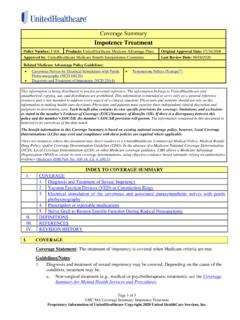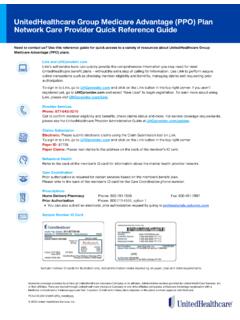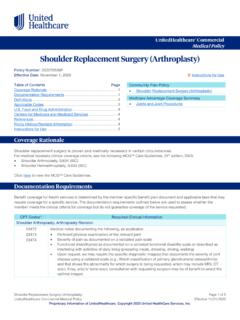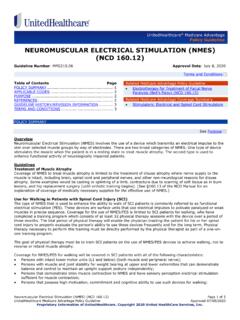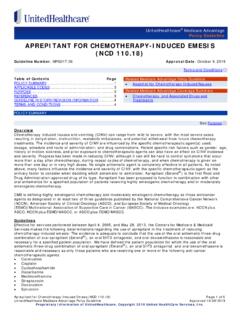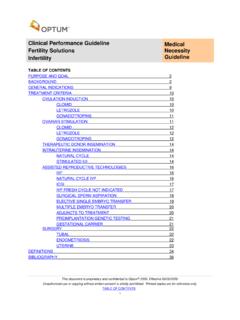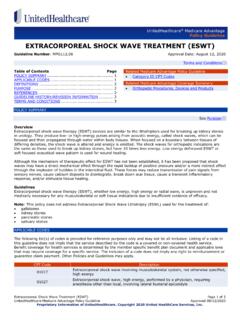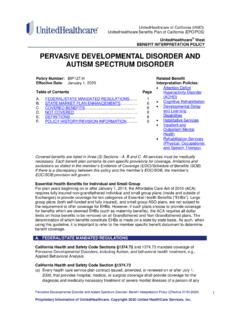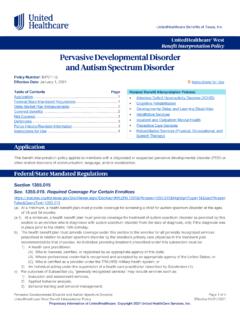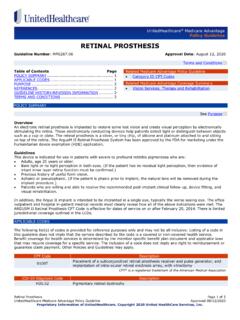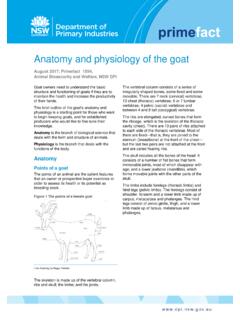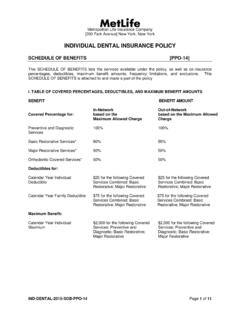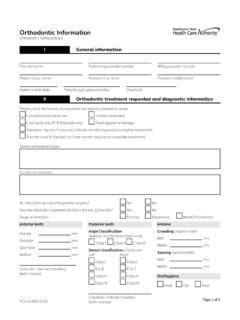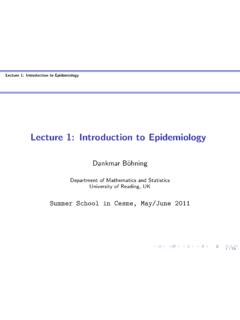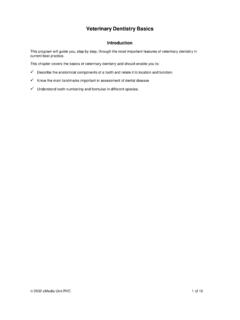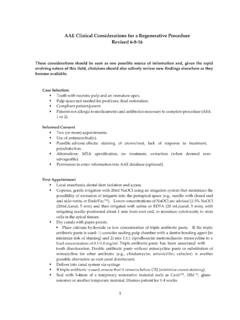Transcription of Surgical Extraction of Impacted Teeth - UHCprovider.com
1 UnitedHealthcare Dental Clinical Policy Surgical Extraction of Impacted Teeth Policy Number: Effective Date: January 1, 2023 Instructions for Use Table of Contents Page Related Dental Policies Coverage Rationale .. 1 Non- Surgical Extractions Definitions .. 2 Surgical Extraction of Erupted Teeth and Retained Applicable Codes .. 2 Roots Description of Services .. 2. Clinical Evidence .. 3. Food and Drug Administration .. 5. References .. 5. Policy History/Revision Information .. 6. Instructions for Use .. 6. Coverage Rationale Surgical Extraction of Soft Tissue, Partially Bony and Complete Bony Impacted Teeth Surgical Extraction of Soft Tissue, Partially Bony and Complete Bony Impacted Teeth is indicated for the following: The facilitation of orthodontic treatment For a tooth/ Teeth in the line of a jaw fracture or complicating fracture management As part of comprehensive treatment in orthognathic surgery Moderate to severe or acute pain, or recurrent episodes that do not respond to conservative treatment ( , pain medication or antibiotics).
2 Non restorable caries Management of, or limiting the progression of periodontal disease In the case of acute/chronic infection (abscess, cellulitis, pericoronitis). Pulpal exposure Non restorable pulpal or periapical lesion Internal resorption As a prophylactic procedure for an underlying medical or Surgical condition ( , organ transplants, alloplastic implants, chemotherapy, radiation therapy prior to intravenous bisphosphonate therapy for cancer). Tumor resection Ectopic position For purposes of prosthetic rehabilitation (partial dentures and complete dentures). Surgical Extraction of Soft Tissue, Partially Bony and Complete Bony Impacted Teeth is not indicated for the following: For prophylactic reasons other than an underlying medical condition For pain or discomfort related to normal tooth eruption Coronectomy Coronectomy is indicated for the following: When clinical criteria for Extraction of Impacted Teeth is met; and If the removal of the complete tooth would result in damage to the neurovascular bundle Surgical Extraction of Impacted Teeth Page 1 of 6.
3 UnitedHealthcare Dental Clinical Policy Effective 01/01/2023. Proprietary Information of UnitedHealthcare. Copyright 2023 United HealthCare Services, Inc. Coronectomy is not indicated for Teeth with the following conditions: Mobility Root surface decay Periapical pathology Horizontal impactions in direct contact with nerves Definitions Completely Bony Impaction: Most or all of a tooth crown is covered by bone; requires mucoperiosteal flap, elevation and bone removal. (ADA). Completely Bony Impaction with Unusual Surgical Complications: Most or all of a crown covered by bone; usually difficult or complicated due to factors such as nerve dissection required, separate closure of maxillary sinus required, or aberrant tooth position. (ADA). Coronectomy: Intentional partial tooth removal performed when a neurovascular complication is likely if the entire Impacted Tooth is removed.
4 (ADA). Impacted Tooth: An unerupted or partially erupted tooth that is positioned against another tooth, bone, or soft tissue so that complete eruption is unlikely. (ADA). Partially Bony Impaction: Part of tooth crown covered by bone; requires mucoperiosteal flap elevation and bone removal. (ADA). Soft Tissue Impaction: Occlusal surface of tooth covered by soft tissue; requires mucoperiosteal flap elevation. (ADA). Applicable Codes The following list(s) of procedure and/or diagnosis codes is provided for reference purposes only and may not be all inclusive. Listing of a code in this policy does not imply that the service described by the code is a covered or non-covered health service. Benefit coverage for health services is determined by the member specific benefit plan document and applicable laws that may require coverage for a specific service.
5 The inclusion of a code does not imply any right to reimbursement or guarantee claim payment. Other Policies and Guidelines may apply. CDT Code Description D7220 Removal of Impacted tooth soft tissue D7230 Removal of Impacted tooth partially bony D7240 Removal of Impacted tooth complete bony D7241 Removal of Impacted tooth complete bony, with unusual Surgical complications D7251 Coronectomy - intentional partial tooth removal, Impacted Teeth only D7922 Placement of intra-socket biological dressing to aid in hemostasis or clot stabilization, per site CDT is a registered trademark of the American Dental Association Description of Services Surgical Extraction of Impacted Teeth is required when the tooth is not erupted in the oral cavity and is covered by soft tissue and/or bone, and the procedure requires the cutting of these tissues.
6 The most commonly affected Teeth are third molars and maxillary canines, but impaction can occur with any Teeth . The placement of intra-socket biological dressings following an Extraction include products made of gelatin, collagen, and cellulose for soft tissue bleeding, and bone wax for cancellous bone bleeding. These products may be needed to aid in hemostasis or clot stabilization and are typically considered inclusive to the primary Extraction procedure. Surgical Extraction of Impacted Teeth Page 2 of 6. UnitedHealthcare Dental Clinical Policy Effective 01/01/2023. Proprietary Information of UnitedHealthcare. Copyright 2023 United HealthCare Services, Inc. Clinical Evidence Smailien et al. (2019) conducted a retrospective study using cone beam computerized tomography (CBCT) to assess the relationship between external root resorption (ERR) on the distal aspect of second molars' roots and positional parameters of Impacted third molars (ITM).
7 Cone beam computed tomography scans of 109 patients (41 males, 68 females; mean age years) with 254 ITM (131 in the maxilla and 123 in the mandible) were retrospectively analyzed. Positional parameters of ITM (mesio-distal position, angulation, impaction depth, and available eruption space) were evaluated. The presence, location, and depth of ERR of adjacent second molars were assessed. Analysis showed a relationship between ITM impaction depth, mesial inclination angle, and the presence of ERR. Mesial inclination angle of more than increased the odds of ERR. occurrence by (95% CI, ). ITM presence at the level of of roots of the adjacent second molar or more apically increased the odds of ERR occurrence by (95% CI, ). No significant correlation was detected between the occurrence of ERR and patient age, gender, or the available eruption space in the mandible.
8 Depth of ERR did not depend on its location. The author's concluded that the incidence of ERR in second molars is significantly associated with mesial inclination and a deep position of ITM. Monaco et al. (2019) conducted a prospective cohort study of early (up to 1 month) and late (from 2 to 60 months). postoperative complications following coronectomy to reduce the risk of neurologic damage to the inferior alveolar nerve (IAN). 116 coronectomies in 94 healthy patients (37 men and 57 women; mean age, years) were completed, and at 5 years'. follow-up, re-evaluated 63 patients with 76 coronectomies. In total, 30 complications were verified. No cases of neurologic lesions to the IAN or lingual nerve were observed after surgery. In the first 3 years, the surgeons extracted migrated roots in 5. cases (6%) without any neurologic lesions to the IAN.
9 No complications were observed from the third to fifth year. The author's concluded no cases of neurologic lesions, no cases of late infection of the retained roots at 5 years, and a low rate of immediate postoperative complications. Further investigations should include a follow-up study at 10 years and more research about the mechanism of pulp healing. Ghaeminia et al. (2016). This Cochrane Database Systematic Review is an update of an existing review published in 2012. The goal is to evaluate the effects of removal compared with retention (conservative management) of asymptomatic disease-free Impacted wisdom Teeth in adolescents and adults. The authors searched the following electronic databases: Cochrane Oral Health's Trials Register through May 24, 2016, the Cochrane Central Register of Controlled Trials (CENTRAL) (2016, Issue 4), MEDLINE Ovid (1946 to 24 May 2016) and Embase Ovid (1980 to 24 May 2016).
10 They also searched and the World Health Organization International Clinical Trials Registry Platform for ongoing and unpublished studies to 24 May 2016. There were no restrictions imposed on language or date of publication, and included studies comparing removal (or absence). with retention (or presence) of asymptomatic disease-free Impacted wisdom Teeth in adolescents or adults. Included, were randomized controlled trials (RCTs) with no restriction on length of follow-up, if available and quasi-RCTs and prospective cohort studies if investigators measured outcomes with follow-up of five years or longer. The previous review included one RCT. with a parallel-group design, which was conducted in a dental hospital setting in the United Kingdom; the search for this update identified one prospective cohort study conducted in the private sector in the USA.
